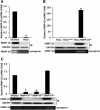Matrix metalloproteinase-10 promotes tumor progression through regulation of angiogenic and apoptotic pathways in cervical tumors
- PMID: 24885595
- PMCID: PMC4022983
- DOI: 10.1186/1471-2407-14-310
Matrix metalloproteinase-10 promotes tumor progression through regulation of angiogenic and apoptotic pathways in cervical tumors
Abstract
Background: Cancer invasion and metastasis develops through a series of steps that involve the loss of cell to cell and cell to matrix adhesion, degradation of extracellular matrix and induction of angiogenesis. Different protease systems (e.g., matrix metalloproteinases, MMPs) are involved in these steps. MMP-10, one of the lesser studied MMPs, is limited to epithelial cells and can facilitate tumor cell invasion by targeting collagen, elastin and laminin. Enhanced MMP-10 expression has been linked to poor clinical prognosis in some cancers, however, mechanisms underlying a role for MMP-10 in tumorigenesis and progression remain largely unknown. Here, we report that MMP-10 expression is positively correlated with the invasiveness of human cervical and bladder cancers.
Methods: Using commercial tissue microarray (TMA) of cervical and bladder tissues, MMP-10 immunohistochemical staining was performed. Furthermore using a panel of human cells (HeLa and UROtsa), in vitro and in vivo experiments were performed in which MMP-10 was overexpressed or silenced and we noted phenotypic and genotypic changes.
Results: Experimentally, we showed that MMP-10 can regulate tumor cell migration and invasion, and endothelial cell tube formation, and that MMP-10 effects are associated with a resistance to apoptosis. Further investigation revealed that increasing MMP-10 expression stimulates the expression of HIF-1α and MMP-2 (pro-angiogenic factors) and PAI-1 and CXCR2 (pro-metastatic factors), and accordingly, targeting MMP-10 with siRNA in vivo resulted in diminution of xenograft tumor growth with a concomitant reduction of angiogenesis and a stimulation of apoptosis.
Conclusion: Taken together, our findings show that MMP-10 can play a significant role in tumor growth and progression, and that MMP-10 perturbation may represent a rational strategy for cancer treatment.
Figures






Similar articles
-
MicroRNA-106a promotes cell migration and invasion by targeting tissue inhibitor of matrix metalloproteinase 2 in cervical cancer.Oncol Rep. 2017 Sep;38(3):1774-1782. doi: 10.3892/or.2017.5832. Epub 2017 Jul 18. Oncol Rep. 2017. PMID: 28731196
-
Treatment with low-dose interferon-alpha restores the balance between matrix metalloproteinase-9 and E-cadherin expression in human transitional cell carcinoma of the bladder.Clin Cancer Res. 2001 Sep;7(9):2840-53. Clin Cancer Res. 2001. PMID: 11555602
-
Short interfering RNA directed against Slug blocks tumor growth, metastasis formation, and vascular leakage in bladder cancer.Med Oncol. 2011 Dec;28 Suppl 1:S413-22. doi: 10.1007/s12032-010-9728-4. Epub 2010 Oct 30. Med Oncol. 2011. PMID: 21053100
-
[The role of metalloproteinases in modification of extracellular matrix in invasive tumor growth, metastasis and angiogenesis].Postepy Hig Med Dosw (Online). 2012 Sep 10;66:609-28. doi: 10.5604/17322693.1009705. Postepy Hig Med Dosw (Online). 2012. PMID: 23001203 Review. Polish.
-
Matrix metalloproteinase inhibitors.Invest New Drugs. 1997;15(1):61-75. doi: 10.1023/a:1005722729132. Invest New Drugs. 1997. PMID: 9195290 Review.
Cited by
-
Oncogenic Mutation BRAF V600E Changes Phenotypic Behavior of THLE-2 Liver Cells through Alteration of Gene Expression.Int J Mol Sci. 2022 Jan 28;23(3):1548. doi: 10.3390/ijms23031548. Int J Mol Sci. 2022. PMID: 35163468 Free PMC article.
-
Spheroid culture models adequately imitate distinctive features of the renal cancer or melanoma microenvironment.In Vitro Cell Dev Biol Anim. 2022 May;58(5):349-364. doi: 10.1007/s11626-022-00685-8. Epub 2022 May 10. In Vitro Cell Dev Biol Anim. 2022. PMID: 35536385
-
Association of MMP-2, RB and PAI-1 with decreased recurrence-free survival and overall survival in bladder cancer patients.Oncotarget. 2017 Sep 6;8(59):99707-99721. doi: 10.18632/oncotarget.20686. eCollection 2017 Nov 21. Oncotarget. 2017. PMID: 29245935 Free PMC article.
-
HLA-BAT1 alters migration, invasion and pro-inflammatory cytokines in prostate cancer.Front Oncol. 2022 Nov 23;12:969396. doi: 10.3389/fonc.2022.969396. eCollection 2022. Front Oncol. 2022. PMID: 36505884 Free PMC article.
-
CircRNA-Mediated Regulation of Angiogenesis: A New Chapter in Cancer Biology.Front Oncol. 2021 Mar 10;11:553706. doi: 10.3389/fonc.2021.553706. eCollection 2021. Front Oncol. 2021. PMID: 33777729 Free PMC article. Review.
References
-
- Krampert M, Bloch W, Sasaki T, Bugnon P, Rülicke T, Wolf E, Bloch W, Sasaki T, Bugnon P, Rülicke T, Wolf E. Activities of the matrix metalloproteinase stromelysin-2 (MMP-10) in matrix degradation and keratinocyte organization in wounded skin. Mol Biol Cell. 2004;15:5242–5254. doi: 10.1091/mbc.E04-02-0109. - DOI - PMC - PubMed
Publication types
MeSH terms
Substances
Grants and funding
LinkOut - more resources
Full Text Sources
Other Literature Sources
Medical
Miscellaneous

